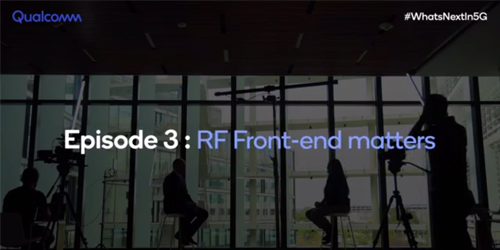Qualcomm Technologies, Inc. announced its next-generation of Qualcomm® RF Front-End (RFFE) solutions for high performance 5G mobile devices. The solutions are designed to support advanced performance and power efficiency capabilities in the newly announced Qualcomm® Snapdragon™ X65 and X62 5G Modem-RF Systems—bringing together modem, RF transceiver, RFFE components with artificial intelligence (AI) assistance and mmWave antenna modules to enable OEMs to design premium 5G devices.
The comprehensive Qualcomm RFFE portfolio includes:
• Seventh-generation Qualcomm® Wideband Envelope Tracker (Qualcomm® QET7100—industry's first multi-mode, multi-output, multi-power amplifier, wideband envelope tracking solution supporting global 5G sub-6 GHz and LTE bands.
• Qualcomm® AI-Enhanced Signal Boost—Industry's first 5G adaptive antenna tuning solution enhanced with AI designed to improve context-based antenna performance and help OEMs address the growing number of antennas and frequency ranges required in 5G mobile devices.
• New integrated 5G/4G power amplifier (PA) modules and diversity modules
“5G presents a level of complexity that our advanced RFFE solutions and comprehensive portfolio can uniquely resolve. We provide OEMs the technological capabilities they need to tackle 5G complexity in order to accelerate time to launch, improve performance and lower development effort for building 5G mobile devices at scale.” said Christian Block, senior vice president and general manager, RFFE, QUALCOMM Germany RFFE GmbH. “Our comprehensive modem-to-antenna solution offers game-changing improvements and enables OEMs to create best-in-class 5G devices in a sleek form factors, without sacrificing performance, connectivity or battery life.”
The RFFE is crucial to design high performance 5G devices with all-day battery life. It consists of many radio-frequency components between the modem and the device’s antennas that shape and manage all the signals sent and received over the air. 5G significantly increases the complexity of the RFFE with over 10,000 frequency band combinations—compared to less than 20 in the early days of 4G.
Qualcomm Technologies’ Modem-RF solution addresses this RFFE complexity, allowing OEMs to spend less time on hardware integration and testing and rather focus more on industrial design and user interface to deliver better products.
The seventh-generation Qualcomm Wideband Envelope Tracker QET7100 can enable 30 percent better power efficiency compared to average power tracking technology from competitors. It supports full 100 MHz bandwidth for new 5G bands along with support for LTE. This allows OEMs to design better performing and sleeker phones without increasing board area since a single tracker can drive multiple 5G and 4G PA through its multi-output support while also providing OEMs flexibility for PA selection.
Qualcomm AI-Enhanced Signal Boost introduces a 5G adaptive antenna tuning solution featuring artificial intelligence. Adaptive antenna tuning helps OEMs address the growing number of antennas and frequency ranges required in 5G mobile devices. The new solution uses an AI-trained model to intelligently detects the user’s hand positioning on the device and dynamically fine-tunes the antennas in real-time for a superior 5G user experience. The AI-based detection improves context accuracy by up to 30 percent, compared to previous generation, resulting in faster data speeds, better coverage and longer battery life. Mobile operators can benefit from improved indoor network coverage derived from enhanced RF performance, while consumers can enjoy sleeker 5G smartphones with superior battery life, call reliability and quality, data speeds and network coverage.
The new integrated 5G/4G PA module (Qualcomm® QPM6679) eliminates the need for external diplexer filters and supports full 100 MHz Envelope Tracking operations for improved power efficiency and higher transmit power, resulting in faster uploads and more reliable connectivity. In addition, a new dual-band diversity module (Qualcomm® QDM5579) is designed with an exceptionally small footprint, the smallest commercially available. Thanks to their advanced integration, these new modules enable considerable savings in board area and therefore help OEMs design premium-looking mobile products. Offering a comprehensive RFFE portfolio and modem-to-antenna solution is what allows OEMs to quickly commercialize devices with support for new frequency bands such as n53, n70 and n259 (41 GHz).
For technical details please visit the Qualcomm RFFE webpage. For an insider’s view at the new Modem-RF Systems and what they mean for the industry and the world, please watch the ‘What’s Next in 5G’ video series.


